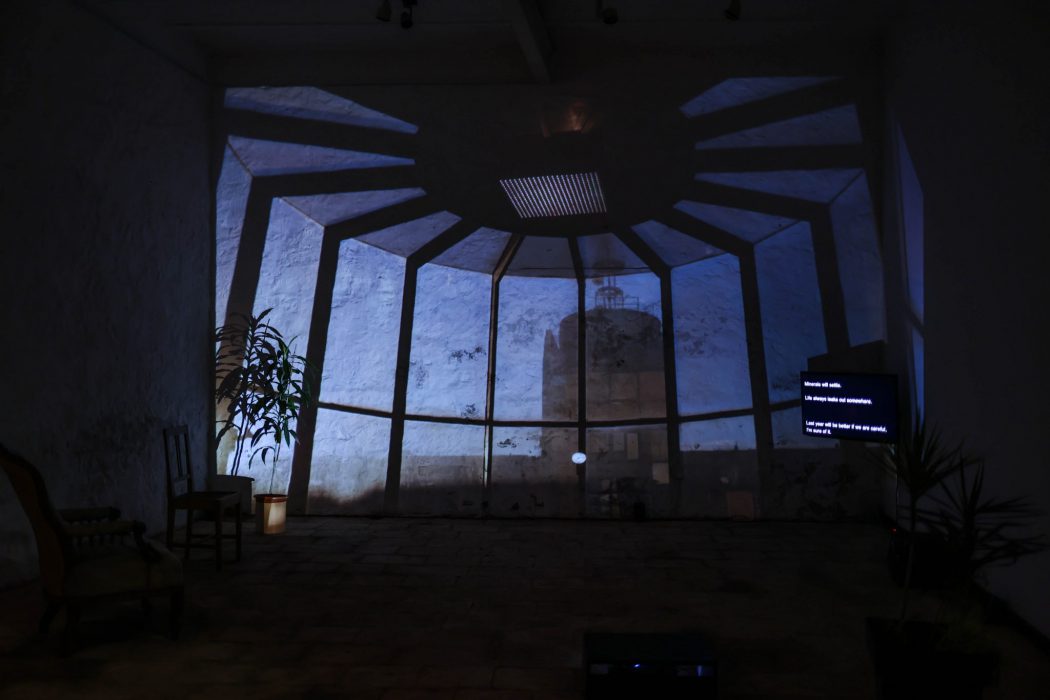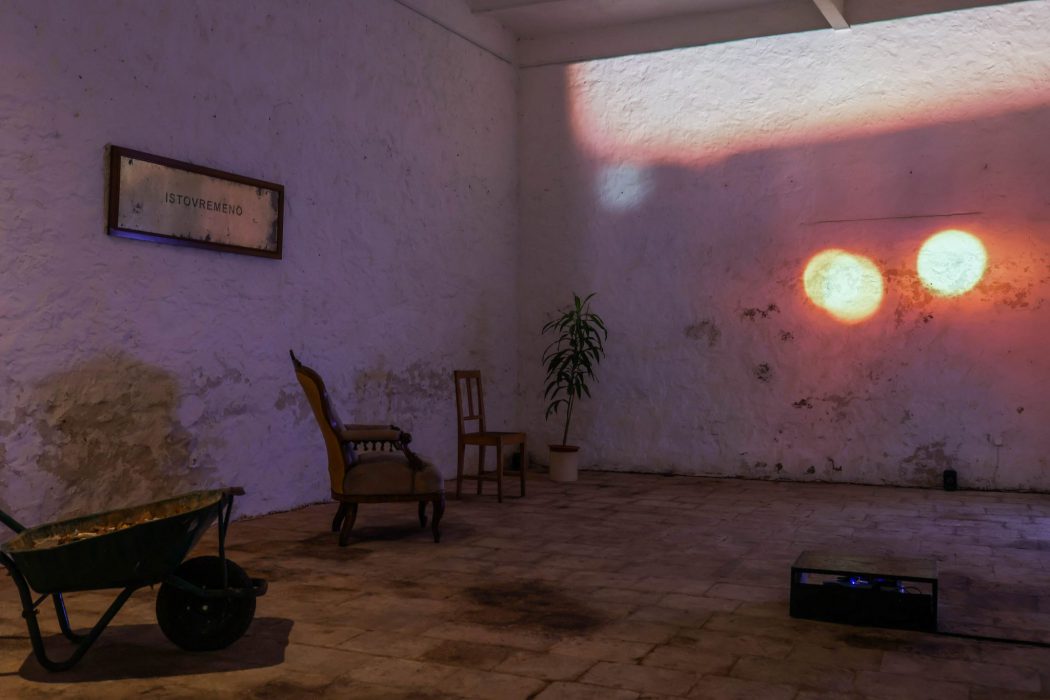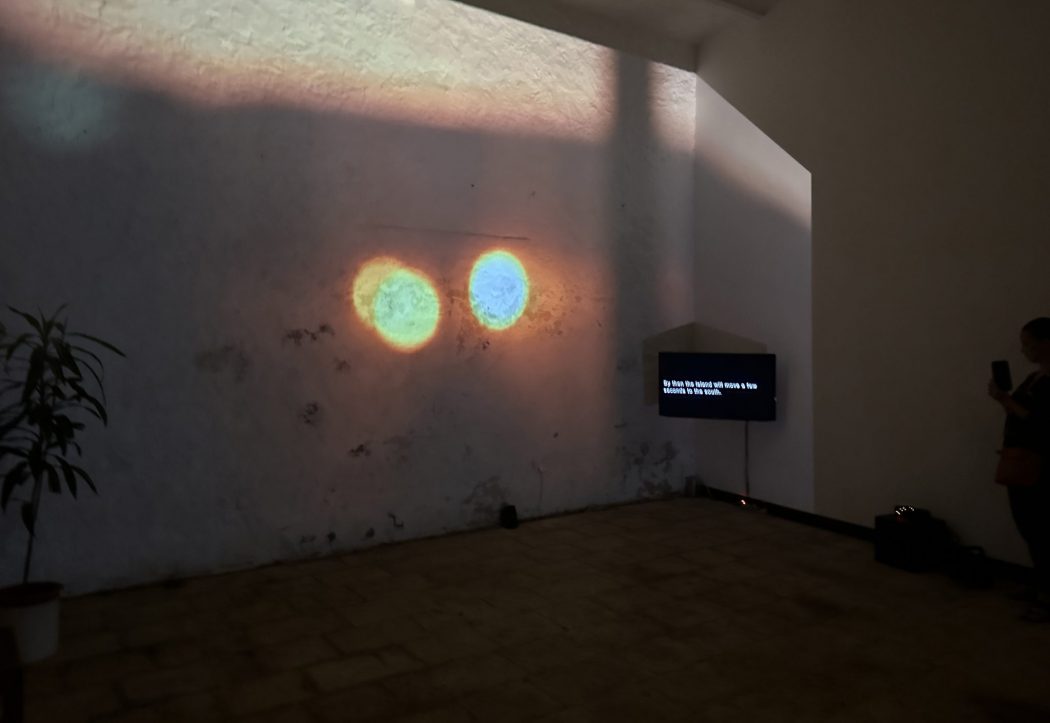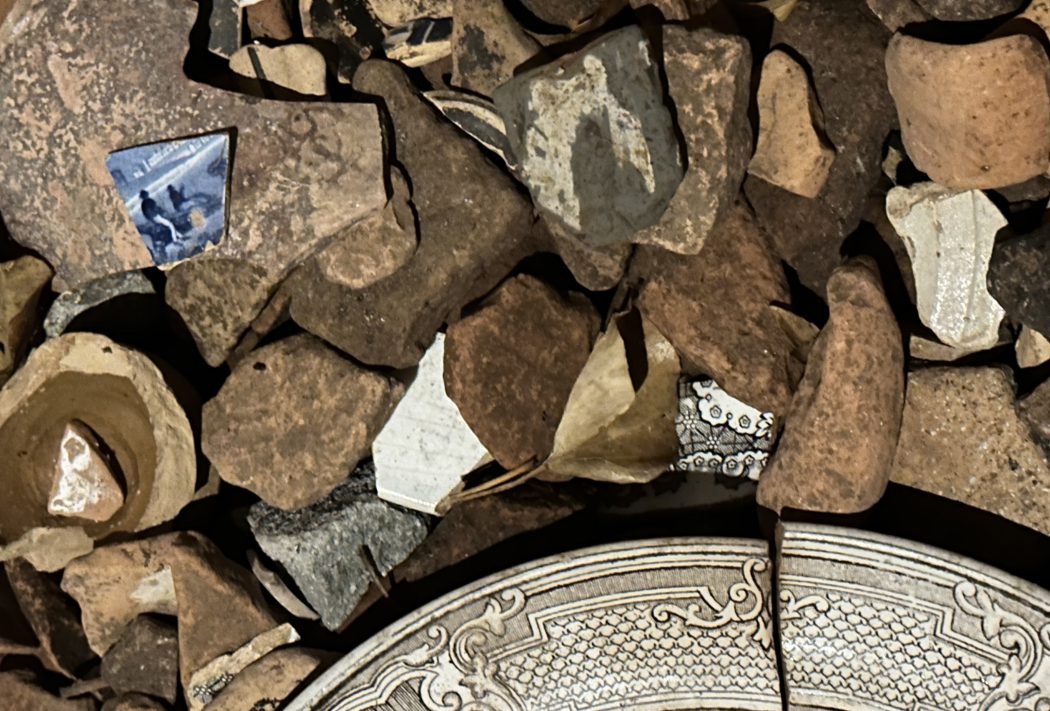Tempus fugit (Time flies), a proverb from Virgil’s Georgics,describes the human perception of the passage of time. In our daily lives, now more than ever, we rely on ever more precise clocks, mechanical, digital and atomic, to measure the passage of time as universally and as accurately as possible, in part to facilitate the transportation systems and just-in-time global delivery of commodities and consumer goods. However, the subjective, lived experience of time, as this exhibition explores, that is developed alongside and within these social, economic and ideological systems, often evades such control. “The time is out of joint,” for Hamlet expressed his melancholy apprehension of his father’s death, and the corruption of Denmark’s court that left no time for mourning. Exploring the haunting remnants of ghost time, capitalist speeds and spectres, and bio-temporalities, this exhibition guides us through the disjointed experience of contemporary time.
At the entrance of the Museum’s exhibition gallery, the visitors encounter Neli Ružić’s installation Now (Kairos),which consists of a black metal clock mounted on a plinth. Although it resembles an everyday time measurement devices, it has unsettling quality. In this clock, the hand showing seconds moves as the base of the clock rotates in the opposite direction, causing the moving hand to stay in the same place. In Zeno’s paradoxes one can never move past a single point, because each point can be divided infinitely, and infinity is impossible to cross. However, as Now (Kairos)evokes, the ever-moving yet immovable clock seems to go beyond the classical linear impossibility of time as Zeno explores it. It is, in a Bergsonian sense — the notion of la durée— time that eludes mathematical calculations. For Henri Bergson, French philosopher of la durée, time is not simply composed of linear points of succession, it is rather a duration that “passes only because it also coexists with itself in the depths of Bergson’s cone of memory”.[1]Bergson refuses to divide time and to measure it in spatial terms. Deleuze terms this ontological time as “non-chronological time”.[2]It is perhaps something like the image of la duréein Ružić’s moving yet unmoved clock that surpasses Zeno’s classical idea of time as spatial line, and restructures the past and present into a simultaneity, rather than a succession: a juxtaposition of now.
Ružić’s audio-video installation on the opposite wall of the gallery,Do we have a plan for yesterday?,further complicates the non-chronological notion of time. The visual part contains a recording of the spiral staircase of the “Youth Centre” building in Split. This socialist building of the 1980s, conceived as never finished “Socialist Youth Centre” became a space used informally by anarchist art groups in 1990s, and since the 2000s has been a more structured home to numerous cultural organisations led by the Multimedia Cultural Centre, which hosts experimental contemporary art exhibitions. Ghosts of these lost meanings echo in Ružić’s work, which builds new connections with the space of the Museum, projecting the out-of-place space into a new context, creating a kind of dislocation both temporal and spatial. The video shows the neglected character of the staircase as a kind of observatory reflecting the light of different times through its glass walls, while the installation’s audio track weaves an alternative temporal schema into the piece. In combination with the objects found at the museum, a cart filled with collected but unsorted archaeological fragments of pottery and furniture from different historical eras, as well as personal histories in the form of an aged mirror that she inherited and engraved with the word Istovremeno (Simultaneously), the voices and objects of the installation function as artefacts of dislocation, adding and forcing together layers of time and creating the sensation of different time periods concurrently. If this destabilises temporal experience, it perhaps also shifts our understanding the planes of historical and experienced time. The sensation of temporal dislocation, according to Paul Greenleaf “may be brought about through looking at photographs and videos or listening to sounds which can trigger memories resurrecting the past returning it to our lived-present”.[3]The audio loop from the piece in combination with visual elements, enable us to contemplate multiple time frames in relation to one another. Time is here imaged as layers pulling apart, rendered out-of-joint so that we look again at the work of time upon place, and on our own passage through time.
Ghosts feature in many of these works, and this is certainly political. Mark Fisher, in his theory of hauntology, proposes that our present is saturated by memories of our expectations that are not fulfilled. The capitalist future is seen to be unstable, a closure of the social potential and haunted by those lost possibilities for social living. While this clearly points to disruptions in time, it also implies material displacement. Fisher explains that speculations about new technologies, which capitalism relies upon to operate its erasure of social life “show that hauntology concerns a crisis of space as well as time” by allowing “events that are spatially distant become available to an audience simultaneously”.[4]“Haunting happens when a space is invaded or otherwise disrupted by a time that is out-of-joint, a dyschronia”.[5]For Fisher, “Hauntology isn’t about the return of the past, but about the fact that the origin was already spectral. We live in a time when the past is present, and the present is saturated with the past. Hauntology emerges as crucial – cultural and political – alternative both to linear history and to postmodernism’s permanent revival”.[6]In Ružić’s installation Do we have a plan for yesterday?, we are confronted with an entity that is “no longer” the presence of a place from the past, that continues to exert its influence. As with Fisher’s hauntology, we are confronted with something that has “not yet” occurred, but was once envisaged, the failure of expected future.
Late capitalism’s algorithms which, as Ružić puts it, “direct and form the future but also the meaning of the moment of the present” are important in Do we have a plan for yesterday?, whose audio track consists of an audio recording of a dialogue in Croatian which is accompanied by the simultaneous rendering of the dialogue in words on a screen in English. The work is set during the Covid lockdown, and in the artist’s words, it “reflects collective and personal disturbances in the perception of time, complete uncertainty and the impossibility of planning.” This dystopian scenario, however, goes beyond its original context. Its confusion-inducing temporal determinants contain at the same time the sense of urgency and the necessity of slowing down, of “decolonising time”. The disembodied voices of this art installation, like melancholic ghosts from the machine narrate:
Today is already full of tomorrow’s shadows.
We can’t lose now, that’s all we have.
If we lose now, when will we stand up?
All that remains is to colonise dreams.
And the horizons of expectations collapse like skyscrapers anyway.
Colonised time is designed to extract value, like colonizers seizing raw materials. It is shaped by the need of capital which destroys diversity in favour of more productive monocultures. For Marx, “an economics of time” underpins all forms of economics. This is why the decolonisation of time is necessary for restauration of sustainability of earth, of our lives and our economy. For Donna Haraway “‘decolonising time’ (…) means learning to inhabit these times of urgent trouble with a memory that this is not and has never been all of time, including all of now”.[7]Decolonised time understands the present that looks “beyond rationales of profit in order to listen to and understand the suffering and the pain of those caught up in processes of colonialization, in order to also act in practical new ways to support these non-colonialist structures.”[8]
The question of nature and bio-temporality is significant as a measure of decolonial time. By breaking of the patterns and decolonising processes of time, Ružić troubles or ruptures conventions of capitalist time, imaging our temporal relation with earth’s ecologies. Images of collapsing nature (moving of land masses, moving towards desert, the light getting stronger, disappearing landscapes) and the sense of urgency in Do we have a plan for yesterday? are a reminder that we find ourselves in an unprecedented time, on the verge of ecological disaster. Here is where Ružić’s work offers aesthetic tools and strategies which problematise the order of time’s past and future. By turning “time as suchinto an object of the aesthetic experience”[9]as Hans-Thies Lehmann puts it, Ružić’s work opens up questions about alternative ways of existing on earth. There is impossibility in the temporality of Do we have a plan for yesterday?, a time of undoing which, like a ghost of the future, haunts the past. This is also a moment of ecological temporality. Our changing climate is not only remaking the future planet, it is also profoundly changing how we understand the past: “Time and space can disappear at any moment. It is too late since long ago”. But there is also a resilience, a new ordering of things: plants will grow, minerals will be deposited. A new assemblage of life’s systems will occur anyway somewhere in the leaks of time, the refugia that take care of different temporalities: “Last year will be better if we are careful. I’m sure everything will be good”.
For this reason, unconventionally, organic growth and plant temporality takes a central place in this exhibition, with Ružić’s installation of potted plants inside the gallery. In this artistic intervention, Ružić branches further outside of the no-longer-and-not-yet. Plants are the epitome of natural beauty in a conventional Kantian sense: they contain aesthetic qualities that elude our understanding, while grasping us as sensation. But as living organisms they also require special care. This changes the character of the exhibition itself. It becomes a live entity that is constantly in flux, growing and evolving in time to ancient patterns written in its genetics. This intervention asks us to consider decolonised time on a deeper level, in a relation of an alterity yet more other than human. Plants are harnessed so often by capital, in the form of industrial agriculture and genetic manipulation. For Ružić the bio-temporalities of plants express both the haunting possibility opened by care, and the difference of the natural world to which we are bound through individual and shared narratives and collective memories. We perhaps see here a different mode of hauntology, a haunting by the ghosts of different kinds of time itself by which Ružić’s artwork asks us to face the many temporal layers that compose human meaning.
Jadra Ryle
[1]Al-Saji, Alia, „The memory of another past: Bergson, Deleuze and a new theory of time“, Continental Philosophy Review (2004), 37: 203-239. p. 205.
[2]Deleuze, Gilles, Cinéma 2, L’image-temps. Paris: Les éditions de minuit, 1985. p. 82.
[3]Greenleaf, Paul, „Temporal Dislocation and Audiovisual Practice“, 2022. p. 24.
[4]Fisher, Mark, Ghosts of My Life, London: Zero books, 2014. p. 20.
[5]Fisher, Mark, „You have always been the caretaker“: the spectral spaces of the Overlook Hotel, 2007. n.p.
[6]Fisher, Mark, „Phonograph Blues“ K-Punk, 19. 10. 2006. n.p.
[7]Haraway, Donna, „Statements on ‘Decolonising Time’“, Excepts from a video interview with Berno Odo Polzer, 2017. https://time-issues.org/haraway-statements-on-decolonizing-time/
[8]Fransworth, Brandon, Curating Contemporary Music Festivals, 2020. p. 274.
[9]Lehmann, Hans-Thies, Postdramatic Theatre, London: Routledge, 2006. p. 156.



